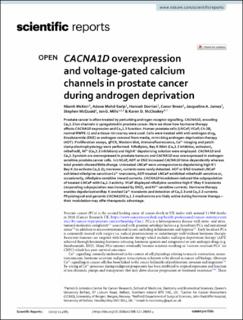| dc.description.abstract | Prostate cancer is often treated by perturbing androgen receptor signalling. CACNA1D, encoding CaV1.3 ion channels is upregulated in prostate cancer. Here we show how hormone therapy affects CACNA1D expression and CaV1.3 function. Human prostate cells (LNCaP, VCaP, C4-2B, normal RWPE-1) and a tissue microarray were used. Cells were treated with anti-androgen drug, Enzalutamide (ENZ) or androgen-removal from media, mimicking androgen-deprivation therapy (ADT). Proliferation assays, qPCR, Western blot, immunofluorescence, Ca2+-imaging and patch-clamp electrophysiology were performed. Nifedipine, Bay K 8644 (CaV1.3 inhibitor, activator), mibefradil, Ni2+ (CaV3.2 inhibitors) and high K+ depolarising solution were employed. CACNA1D and CaV1.3 protein are overexpressed in prostate tumours and CACNA1D was overexpressed in androgen-sensitive prostate cancer cells. In LNCaP, ADT or ENZ increased CACNA1D time-dependently whereas total protein showed little change. Untreated LNCaP were unresponsive to depolarising high K+/Bay K (to activate CaV1.3); moreover, currents were rarely detected. ADT or ENZ-treated LNCaP exhibited nifedipine-sensitive Ca2+-transients; ADT-treated LNCaP exhibited mibefradil-sensitive or, occasionally, nifedipine-sensitive inward currents. CACNA1D knockdown reduced the subpopulation of treated-LNCaP with CaV1.3 activity. VCaP displayed nifedipine-sensitive high K+/Bay K transients (responding subpopulation was increased by ENZ), and Ni2+-sensitive currents. Hormone therapy enables depolarization/Bay K-evoked Ca2+-transients and detection of CaV1.3 and CaV3.2 currents. Physiological and genomic CACNA1D/CaV1.3 mechanisms are likely active during hormone therapy—their modulation may offer therapeutic advantage. | en_US |

